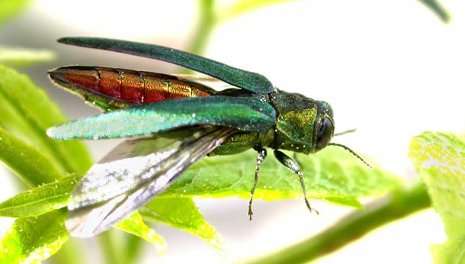Wasps may be battling ash-killing beetles

Five years ago, a Michigan Technological University entomologist set loose a swarm of tiny wasps in the woods around Calumet, Mich. His aim: to combat the invasion of a shiny, green beetle deadly to America's ash trees. Now there's evidence that the wasps are settling in and doing their job.
Though harmless to native insects (and people), these three wasp species are parasites of the emerald ash borer, an Asian beetle that has killed tens of millions of ash trees in Canada and the US. For over a decade, the borer has been chewing its way through ash trees in Canada and the US and prompting fears that these graceful shade trees may go the way of the American chestnut. Andrew Storer's team is part of a concerted effort to save them.
Government agencies and research institutions from throughout the eastern US and Canada have banded together to fight the borer, which has been called "the most destructive and economically costly forest insect to ever invade North America."
Emerald ash borers invade Michigan
Emerald ash borers are no big deal in their native Asia, where trees have evolved natural defenses, and parasitic insects help keep their numbers in check. But in the 1990s, they made landfall in southeastern Michigan, probably in pallets from China, and found themselves in the midst of a massive, undefended salad bar.
People first noticed the emerald ash borer in 2002, when ash trees in communities near Detroit began dying by the thousands. The adult beetles only nibble the leaves, but their larvae eat the inner bark, or phloem, which transports water and nutrients, and the trees die.
Since then, the emerald ash borer has spread throughout the eastern US and Canada, including Michigan's Upper Peninsula. It's there that Storer and his team released three species of tiny wasps on ash-borer infested trees in 2010 and again in 2011. All three species, which were provided by provided by the USDA Animal Plant Health Inspection Service, parasitize the emerald ash borer in Asia, laying their eggs in ash borer larvae and eggs.
In 2012, Storer's team returned to the 11 release sites and recovered two different species of the wasps. They definitely weren't the original insects; adult wasps have a short life span. That means that the first generation had been able to parasitize the ash borer and reproduce.
And this summer, funded by $50,000 from the USDA Animal Plant Inspection Service, Storer's team has recovered ash borer eggs that have been parasitized by one of the wasps.
The team has also set about 200 traps for the adult wasps themselves, some near the original release sites and others farther away, to see if the wasps may be spreading.
Wasps parasitize ash borer eggs
"We know the egg parasite has survived and is out there," Storer said. "As we gather more data, we'll find out what proportion of the ash borer's eggs have been parasitized."
As tantalizing as this may appear, whether or not the wasps can stem the ash borer tide remains to be seen. Determining if they have taken hold and are having an effect on the health of the forest's ash trees is a complex, time-consuming task. Storer hopes they will eventually receive support for an in-depth study to revisit previously established forest health-monitoring plots to determine if those wasps are making a real difference to ash trees.
"Sometimes it's hard to get money to go back and measure longer term impacts, even though the true scientific value in assessing forest health comes from measuring change," Storer said.
Those measurements would provide critical information for forest managers trying to save the ash tree. "If the wasps are only parasitizing 1 percent of the eggs, it won't have an impact," Storer said. "But if they are parasitizing 95 percent, we can say, look, this could be part of an answer."
Provided by Michigan Technological University




















